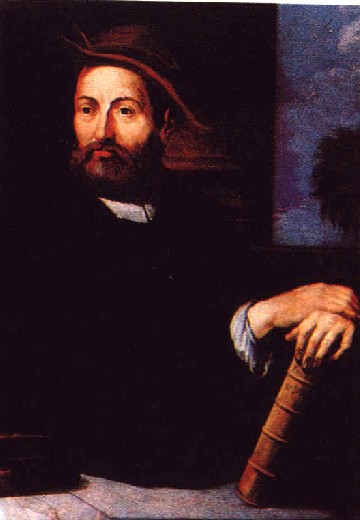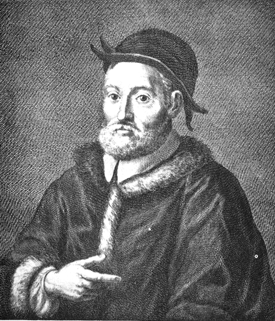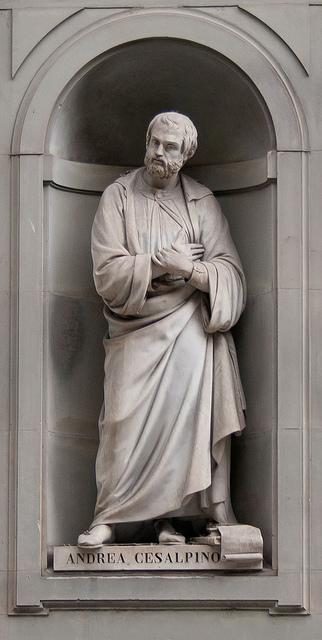<Back to Index>
- Physician and Philosopher Andrea Cesalpino, 1524
- Composer Aram Ilyich Khachaturian, 1903
- Writer and Political Activist Thomas Mann, 1875
PAGE SPONSOR



Andrea Cesalpino (Latinized as Andreas Cæsalpinus) (1524 or 1525 – February 23, 1603) was an Italian physician, philosopher and botanist.
In his works he classified plants according to their fruits and seeds, rather than alphabetically or by medicinal properties. In 1555, he succeeded Luca Ghini as director of the botanical garden in Pisa. The botanist Pietro Castelli was one of his students. Cesalpino also did limited work in the field of physiology. He theorized a circulation of the blood. However, he envisioned a "chemical circulation" consisting of repeated evaporation and condensation of blood, rather than the concept of "physical circulation" popularized by the writings of William Harvey (1578 – 1657). Cesalpino was born in Arezzo, Tuscany. For his studies at the University of Pisa his instructor in medicine was R. Colombo (d. 1559), and in botany the celebrated Luca Ghini. After completing his course he taught philosophy, medicine, and botany for many years at the same university, besides making botanical explorations in various parts of Italy. At this time the first botanical gardens in Europe were laid out; the earliest at Padua, in 1546; the next at Pisa in
1547 by Ghini, who was its first director. Ghini was succeeded by
Cesalpino, who had charge of the Pisan garden 1554 - 1558. When far
advanced in years Cesalpino accepted a call to Rome as professor of medicine at University of Rome La Sapienza and physician to Pope Clement VIII. It is not positively certain whether he also became the chief superintendent of the Roman botanical garden which had been laid out about 1566 by one of his most celebrated pupils, Michele Mercati. All
of Cesalpino's writings show the man of genius and the profound
thinker. His style, it is true, is often heavy, yet in spite of the
scholastic form in which his works are cast, passages of great beauty
often occur. Modern botanists and physiologists who are not acquainted
with the writings of Aristotle find
Cesalpino's books obscure; their failure to comprehend them has
frequently misled them in their judgment of his achievement. No
comprehensive summing up of the results of Cesalpino's investigations,
founded on a critical study of all his works has appeared, neither has
there been a complete edition of his writings. Seven of these are
positively known, and most of the seven have been printed several
times, although none have appeared since the 17th century. His most important philosophical work is Quaestionum peripateticarum libri V (1569).
Cesalpino proves himself in this to be one of the most eminent and
original students of Aristotle in the 16th century. His writings,
however, show traces of the influence of Averroes, hence he is an Averroistic Aristotelean; apparently he was also inclined to pantheism, consequently he was included, later, in the Spinozists before Spinoza. A Protestant opponent of Aristotelean views, Nicolaus Taurellus wrote several times against Cesalpino. The work of Taurellus entitled Alpes cæsae, etc.
(1597), is entirely devoted to combating the opinions of Cesalpino, as
the play on the name Cæsalpinus shows. Nearly one hundred years
later Cesalpino's views were again attacked by Samuel Parker, in a work entitled Disputationes de Deo et providentia divina (1678). Cesalpino repeatedly asserted the steadfastness of his Catholic principles
and his readiness to acknowledge the falsity of any philosophical
opinions expounded by him as Aristotelean doctrine, which should be
contrary to revelation. In Italy he was in high favour both with the secular and spiritual rulers.
Cesalpino's physiological investigations concerning the circulation of the blood are
well known, but even up to the present time they have been as often
overestimated as undervalued. An examination of the various passages in
his writings which bear upon the question shows that although it must
be said that Celsalpino had penetrated further into the secret of
circulation of the blood than any other physiologist before William Harvey,
still he had not attained to a thorough knowledge, founded on
anatomical research, of the entire course of the blood. Besides the work Quæstionum peripateticarum already mentioned, reference should be made to Quaestionum medicarum libri duo (1593). His most important publication was De plantis libri XVI (1583). The date of its publication, 1583, is one of the most important in the history of botany before Carolus Linnaeus. The work is dedicated to the Grand Duke Francesco I de' Medici. Unlike the "herbals" of that period, it contains no illustrations. The first section,
including thirty pages of the work, is the part of most importance for
botany in general. From the beginning of the 17th century up to the
present day botanists have agreed in the opinion that Cesalpino in this
work, in which he took Aristotle for his guide, laid the foundation of
the morphology and physiology of plants and produced the first scientific classification of flowering plants.
Three things, above all, give the book the stamp of individuality: the
large number of original, acute observations, especially on flowers,
fruits, and seeds, made, moreover, before the invention of the microscope,
the selection of the organs of fructification for the foundation of his
botanical system; finally, the ingenious and at the same time strictly
philosophical handling of the rich material gathered by observation.
Cesalpino issued a publication supplementary to this work, entitled Appendix ad libros de plantis et quaestiones peripateticas (1603). Cesalpino is also famous in the history of botany as one of the first botanists to make an herbarium; one of the oldest herbaria still in existence is that which he arranged about 1550 - 60 for Bishop Alfonso Tornabono. After many changes of fortune the herbarium is now in the Museo di Storia Naturale di Firenze at Florence.
It consists of 260 folio pages arranged in three volumes bound in red
leather, and contains 768 species of plants. A work of some value for chemistry, mineralogy, and geology was issued by him under the title De metallicis libri tres (Rome, 1596). Some of its matter recalls the discoveries made at the end of the eighteenth century, as those of Antoine Lavoisier and René Just Haüy, it also shows a correct understanding of fossils. The Franciscan monk Charles Plumier gave the name of Cæsalpinia to
a plant genus and Linnaeus retained it in his system. At the present
day this genus includes approximately 150 species and belongs the family Fabaceae, subfamily of Cæsalpinioideae, which contains a large number of useful plants. Linnaeus in his
writings often quotes his great predecessor in the science of botany
and praises Cesalpino in the following lines: Quisquis hic exstiterit primos concedat honores
The standard author abbreviation Cesalpino is used to indicate this individual as the author when citing a botanical name.
Casalpine Tibi primaque certa dabit.